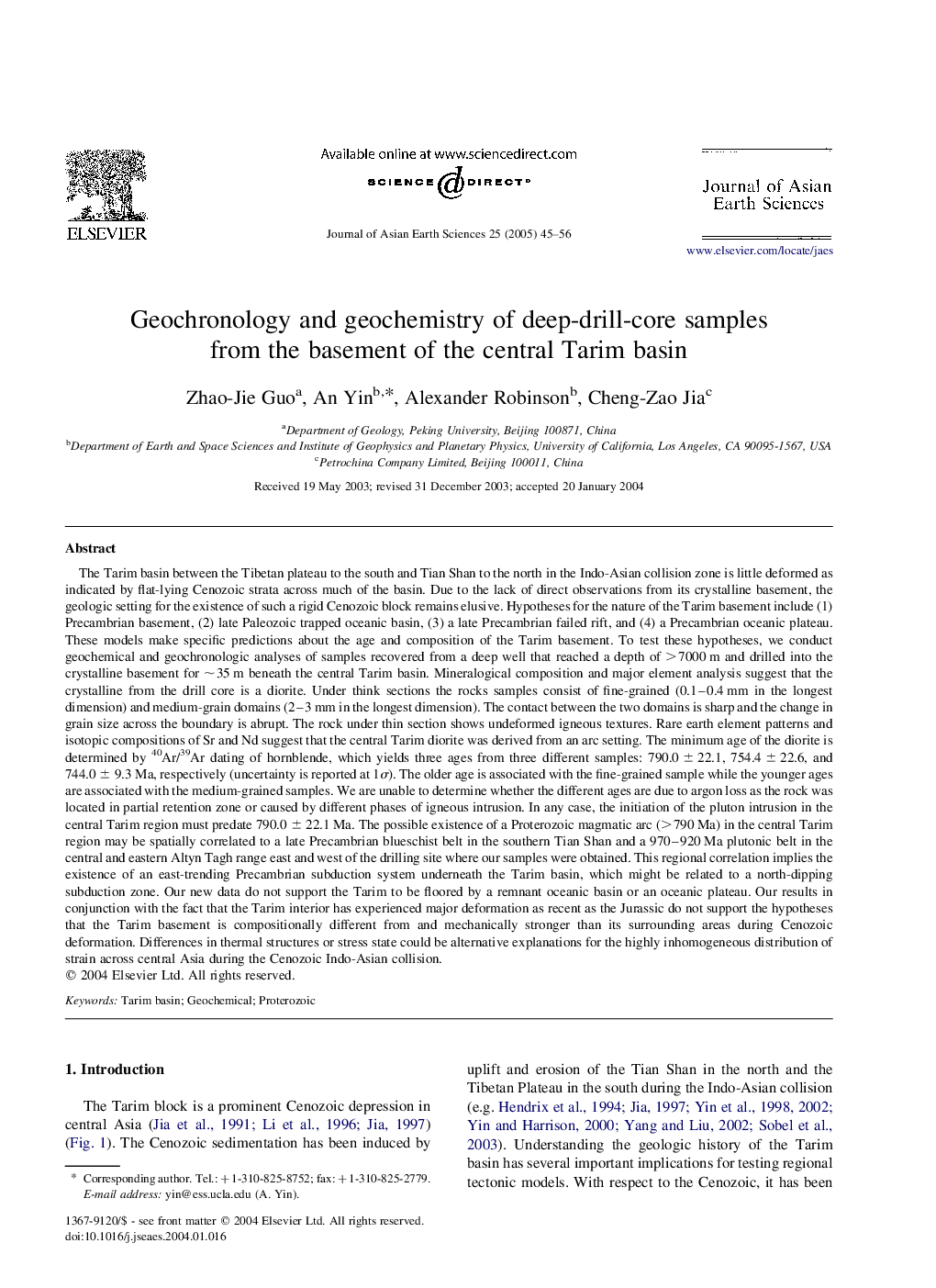| کد مقاله | کد نشریه | سال انتشار | مقاله انگلیسی | نسخه تمام متن |
|---|---|---|---|---|
| 9535747 | 1356899 | 2005 | 12 صفحه PDF | دانلود رایگان |
عنوان انگلیسی مقاله ISI
Geochronology and geochemistry of deep-drill-core samples from the basement of the central Tarim basin
دانلود مقاله + سفارش ترجمه
دانلود مقاله ISI انگلیسی
رایگان برای ایرانیان
موضوعات مرتبط
مهندسی و علوم پایه
علوم زمین و سیارات
زمین شناسی
پیش نمایش صفحه اول مقاله

چکیده انگلیسی
The Tarim basin between the Tibetan plateau to the south and Tian Shan to the north in the Indo-Asian collision zone is little deformed as indicated by flat-lying Cenozoic strata across much of the basin. Due to the lack of direct observations from its crystalline basement, the geologic setting for the existence of such a rigid Cenozoic block remains elusive. Hypotheses for the nature of the Tarim basement include (1) Precambrian basement, (2) late Paleozoic trapped oceanic basin, (3) a late Precambrian failed rift, and (4) a Precambrian oceanic plateau. These models make specific predictions about the age and composition of the Tarim basement. To test these hypotheses, we conduct geochemical and geochronologic analyses of samples recovered from a deep well that reached a depth of >7000 m and drilled into the crystalline basement for â¼35 m beneath the central Tarim basin. Mineralogical composition and major element analysis suggest that the crystalline from the drill core is a diorite. Under think sections the rocks samples consist of fine-grained (0.1-0.4 mm in the longest dimension) and medium-grain domains (2-3 mm in the longest dimension). The contact between the two domains is sharp and the change in grain size across the boundary is abrupt. The rock under thin section shows undeformed igneous textures. Rare earth element patterns and isotopic compositions of Sr and Nd suggest that the central Tarim diorite was derived from an arc setting. The minimum age of the diorite is determined by 40Ar/39Ar dating of hornblende, which yields three ages from three different samples: 790.0±22.1, 754.4±22.6, and 744.0±9.3 Ma, respectively (uncertainty is reported at 1Ï). The older age is associated with the fine-grained sample while the younger ages are associated with the medium-grained samples. We are unable to determine whether the different ages are due to argon loss as the rock was located in partial retention zone or caused by different phases of igneous intrusion. In any case, the initiation of the pluton intrusion in the central Tarim region must predate 790.0±22.1 Ma. The possible existence of a Proterozoic magmatic arc (>790 Ma) in the central Tarim region may be spatially correlated to a late Precambrian blueschist belt in the southern Tian Shan and a 970-920 Ma plutonic belt in the central and eastern Altyn Tagh range east and west of the drilling site where our samples were obtained. This regional correlation implies the existence of an east-trending Precambrian subduction system underneath the Tarim basin, which might be related to a north-dipping subduction zone. Our new data do not support the Tarim to be floored by a remnant oceanic basin or an oceanic plateau. Our results in conjunction with the fact that the Tarim interior has experienced major deformation as recent as the Jurassic do not support the hypotheses that the Tarim basement is compositionally different from and mechanically stronger than its surrounding areas during Cenozoic deformation. Differences in thermal structures or stress state could be alternative explanations for the highly inhomogeneous distribution of strain across central Asia during the Cenozoic Indo-Asian collision.
ناشر
Database: Elsevier - ScienceDirect (ساینس دایرکت)
Journal: Journal of Asian Earth Sciences - Volume 25, Issue 1, April 2005, Pages 45-56
Journal: Journal of Asian Earth Sciences - Volume 25, Issue 1, April 2005, Pages 45-56
نویسندگان
Zhao-Jie Guo, An Yin, Alexander Robinson, Cheng-Zao Jia,